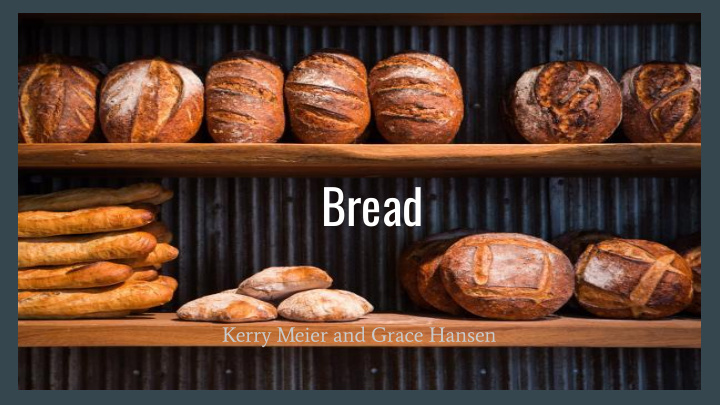



Bread Kerry Meier and Grace Hansen
History of Bread in France Bread making started 30,000 years ago 1788-1789 France went through a massive starvation that lead to a shortage of bread New recipe for less expensive ingredients 1920 baguette bread was created
Le Petit Metron
Pharaoh Bread - Kamut https://www.belfasttelegraph.co.uk/life/features/the-ancient-pharaoh-grain-thats-taking-the-world-by-storm-37193665.html
History of Bread In America Columbus brought over bread in 1492 1800 bread was put into pans instead of loose forms Commercial yeast 1968 Chillicothe Bakery Company sold first loaf of sliced bread by Otto Rohwedder in 1928
Cost of Bread Throughout Time 9 ¢ 11 ¢ 12 ¢ 22 ¢ 25 ¢ 50 ¢ 70 ¢ $ 2.79 $1.98 $ 1.50 1930 1940 1950 1960 1970 1980 1990 2009 2013 2019
Fougasse Pain Complet Baguette Brioche Bread Pain de Ficelle Campagne
How Bread is Made Main ingredient is wheat (United States is 3rd and France is 11th) Four ingredients flour, salt, vinegar, yeast, vegetable fat Leavening makes the bread rise (Yeast) 190 degrees Barrel-Shaped, Baking Chambers, clay or stone ovens
Farm To Fork: US vs France US France Packaging Plastic bags, paper bags, boxed, Paper, plastic (hybrid), cloth, vacuum sealed, cloth (tea) wrapped, unpackaged hard plastic, unpackaged French Bread Law 1993 FDA regulated Shelf Life Store bought: 3 days-3 weeks Boulangerie: 2-3 days Delivery & Transportation Land Land (truck, bicycle, foot) Sea Air Bread Connotation Gluten-free Foundational (All 3 meals) Atkins diet Historic Ketogenic Essential Low-carb Cultural
Labeling and Production The red label or Rouge Label is a national sign, which refers to products which by their terms of ● production or manufacture have a higher level of quality compared to other similar products usually marketed. ● Quality refers to all the properties and characteristics of a product that give it its ability to satisfy explicit or implicit needs ● The superior quality is based on: production conditions, which differ from the conditions of production of usually marketed similar ○ products, ○ product image in terms of its conditions of production, elements of the presentation or service. ○
Industrialization and Bread production Mainstream production has increased to meet the ● demands of consumption Technological and machinery advancements has ● improved efficiency of production in the baking and pastry industry ○ Large scale, dough laminating machines Digital ovens ○ ○ Steam releasing Currently, 90% of croissants are industrial and only ● 10% are handmade
Le Petit Mitron Pastry and croissant ingredients: ● Butter: France ○ Flour: France ○ Chocolate: Belgium and France ○ Bread ingredients: ● Grain: Montana (Bread of Pharaoh’s) and Louvre Valley (Bread of Angel’s) ○ Output meets demand, which reduces costs and in turn waste ● “I bake according to the number of customers that come to eat my bread.” ○ Bread that is not consumed is transformed and incorporated into other dishes ●
Key Takeaways Small Companies = Connections ● Sustainability ● ● Ideas to bring into everyday lives Plant-based proteins in nutrition and sports performance ● Higher protein content (6 gram protein/100 grams) ● Anaerobic and aerobic athletes ●
References https://www.fda.gov/food/food-ingredients-packaging/food-ingredient-packaging-terms ● ● https://www.cooksinfo.com/french-bread-law-1993 ● https://www.inao.gouv.fr/eng/Official-signs-identifying-quality-and-origin/Label-Rouge-Red-Label
Recommend
More recommend